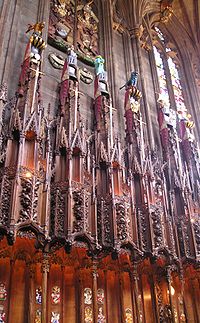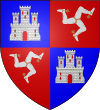Portal:Heraldry
Welcome to the Heraldry and Vexillology Portal!


Vexillology (from the Latin vexillum, a flag or banner) is the scholarly study of flags, including the creation and development of a body of knowledge about flags of all types, their forms and functions, and of scientific theories and principles based on that knowledge. Flags were originally used to assist military coordination on the battlefield, and have evolved into a general tool for signalling and identification, particularly identification of countries.
Heraldry encompasses all of the duties of a herald, including the science and art of designing, displaying, describing and recording coats of arms and badges, as well as the formal ceremonies and laws that regulate the use and inheritance of arms. The origins of heraldry lie in the medieval need to distinguish participants in battles or jousts, whose faces were hidden by steel helmets.
Selected article

Swedish heraldry refers to the cultural tradition and style of heraldic achievements in modern and historic Sweden. It belongs culturally to the German-Nordic heraldic tradition, noted for its multiple helmets and crests which are treated as inseparable from the shield, repetition of colours and charges between the shield and the crest, and its scant use of heraldic furs. Swedish heraldry is similar to Danish heraldry; both were heavily influenced by German heraldry. The medieval history of the Nordic countries was closely related, so they developed their heraldic individuality rather late. Swedish and Finnish heraldry have a shared history prior to the Diet of Porvoo in 1809. Unlike the macaronic and highly stylized English blazon, Swedish heraldry is described in plain language, using only Swedish terminology.
In Sweden today, the official coats of arms of corporations and government offices are protected by Swedish law, if the coat of arms is registered with the Swedish Patent and Registration Office. Heraldic arms of common citizens (burgher arms), however, are less strictly controlled; these are recognised by inclusion in the annually published Scandinavian Roll of Arms. (more...)
Selected flag

In Article 18 of the Law on the National Arms, Flag, and Anthem (Ley Sobre El Escudo, la Bandera y el Himno Nacionales) there is a listing of dates that the Mexican flag is flown by all branches of government. Civilians are also encouraged to display the national flag on these days. Many of the dates listed in the law denote significant events and people that shaped of Mexican identity and the course of its History. Some of the holidays and commemorations listed require the flag to be flown at half-staff. The national flag can be flown any day of the year by civilians or at festive occasions in persurrence to Article 15 of the Law on the National Arms, Flag, and Anthem. (more...)
Selected biography

Sir John Vanbrugh (pronounced "Van'-bru") (January 24, 1664? – March 26, 1726) was an English dramatist, officer of arms and architect, perhaps best known as the designer of Blenheim Palace. He wrote two argumentative and outspoken Restoration comedies, The Relapse (1696) and The Provoked Wife (1697), which have become enduring stage favourites but originally occasioned much controversy.
Vanbrugh was in many senses a radical throughout his life. As a young man and a committed Whig, he was part of the scheme to overthrow James II, put William III on the throne and protect English parliamentary democracy, dangerous undertakings which landed him in the dreaded Bastille of Paris as a political prisoner. In his career as a playwright, he offended many sections of Restoration and 18th-century society, not only by the sexual explicitness of his plays, but also by their messages in defence of women's rights in marriage. He was attacked on both counts, and was one of the prime targets of Jeremy Collier's Short View of the Immorality and Profaneness of the English Stage. In his architectural career, he created what came to be known as English Baroque. His architectural work was as bold and daring as his early political activism and marriage-themed plays, and jarred conservative opinions on the subject. Vanbrugh also held the heraldic offices of Carlisle Herald and Clarenceux King of Arms. (more...)
Selected picture

The chapel of the Order of the Thistle in St Giles Cathedral. Above each stall the knight's helmet with crest and mantling (and, if a peer, the coronet of rank) is displayed. At the back of each stall is a plate bearing the knight's coat of arms.
Did you know...
- ...that the triskelion (pictured) in MacLeod heraldry originates from a belief that the clan's founder, Leod, was a son of a king of Mann?
- ...that the herald Robert Glover was appointed to the office of Norroy King of Arms jointly with his 82-year-old father-in-law William Flower in 1580?
- ...that the current rendering of the mermaid in the coat of arms of Ustka is the result of a two-year debate over the size of her breasts?
- ...that the Duke of Cambridge's Personal Canadian Flag was first used during the 2011 royal tour of Canada?
- ...that in The Stages of Life, German painter Caspar David Friedrich depicted his son holding a Swedish flag because Friedrich considered himself half-Swedish?
Related portals
|
|
|
Heraldry Web resources
Authorities
- Belgium - The Council of Nobility, Flemish Heraldic Council and Council of Heraldry and Vexillology of the French Community
- Canada - Canadian Heraldic Authority and see also Public Register of Arms, Flags and Badges
- England, Wales, and Northern Ireland - The College of Arms
- Ireland - The Office of the Chief Herald of Ireland
- Netherlands - High Council of Nobility
- Portugal - Instituto da Nobreza Portuguesa
- Scotland - The Court of the Lord Lyon
- South Africa - South African Bureau of Heraldry
- Sweden - National Board of Heraldry, The National Archive
- United States Army - The United States Army Institute of Heraldry
Societies
- Greek Heraldry Society
- The Academy of Heraldic Science Czech republic
- The American College of Heraldry
- The American Heraldry Society
- The Augustan Society
- The Australian Heraldry Society Inc.
- Bulgarian Heraldry and Vexillology Society
- The Center for Research of Orthodox Monarchism
- Cambridge University Heraldic and Genealogical Society
- Chiltern Heraldry Group
- The College of Dracology
- Croatian Heraldic and Vexillologic Association
- The Finnish Heraldic Society
- Fryske Rie foar Heraldyk
- Hellenic Armigers Society
- Guild of Heraldic Artists
- Genealogical Society of Ireland
- Heraldry Research Institute (Japan)
- The Heraldry Society
- The Heraldry Society of Africa
- The Heraldry Society of New Zealand Inc.
- The Heraldry Society of Scotland
- The Heraldry Society of Southern Africa
- The Institute of Heraldic and Genealogical Studies
- The International Association of Amateur Heralds
- Italian Center of Vexillological Studies
- Lancashire Heraldry Group
- Macedonian Heraldry Society
- New England Historic Genealogical Society Committee on Heraldry
- Norwegian Heraldry Society
- Oxford University Heraldry Society
- Polish Heraldry Society
- Polish Nobility Confederation
- Real Academia Matritense de Heráldica y Genealogía - Royal Academy of Heraldry and Genealogy of Madrid
- Romanian Institute for Genealogy and Heraldry
- The Royal Heraldry Society of Canada
- The Russian College of HeraldryThe Russian College of Heraldry
- Serbian Heraldic Society
- Societas Heraldica Scandinavica
- Societas Heraldica Slovenica
- Swedish Heraldic Society
- Ukrainian Heraldry Society
- Royal Association Genealogical and Heraldic Office of Belgium
Vexillology
Software
- Coat of Arms Visual Designer web-based program
- Puncher Heraldry Program
- Blazonry Server - pyBlazon
- DrawShield - creates SVG shield or arms image from blazon
- CoaMaker - web-based tool
- Blazon95 and BLAZONS! 2000, older Windows applications
Texts
- Heraldry, historical and popular : with seven hundred illustrations (1863)
- A Complete Guide to Heraldry (1909)
Other
Wikimedia
The following Wikimedia Foundation sister projects provide more on this subject:
-
Commons
Free media repository -
Wikibooks
Free textbooks and manuals -
Wikidata
Free knowledge base -
Wikinews
Free-content news -
Wikiquote
Collection of quotations -
Wikisource
Free-content library -
Wikispecies
Directory of species -
Wikiversity
Free learning tools -
Wikivoyage
Free travel guide -
Wiktionary
Dictionary and thesaurus












